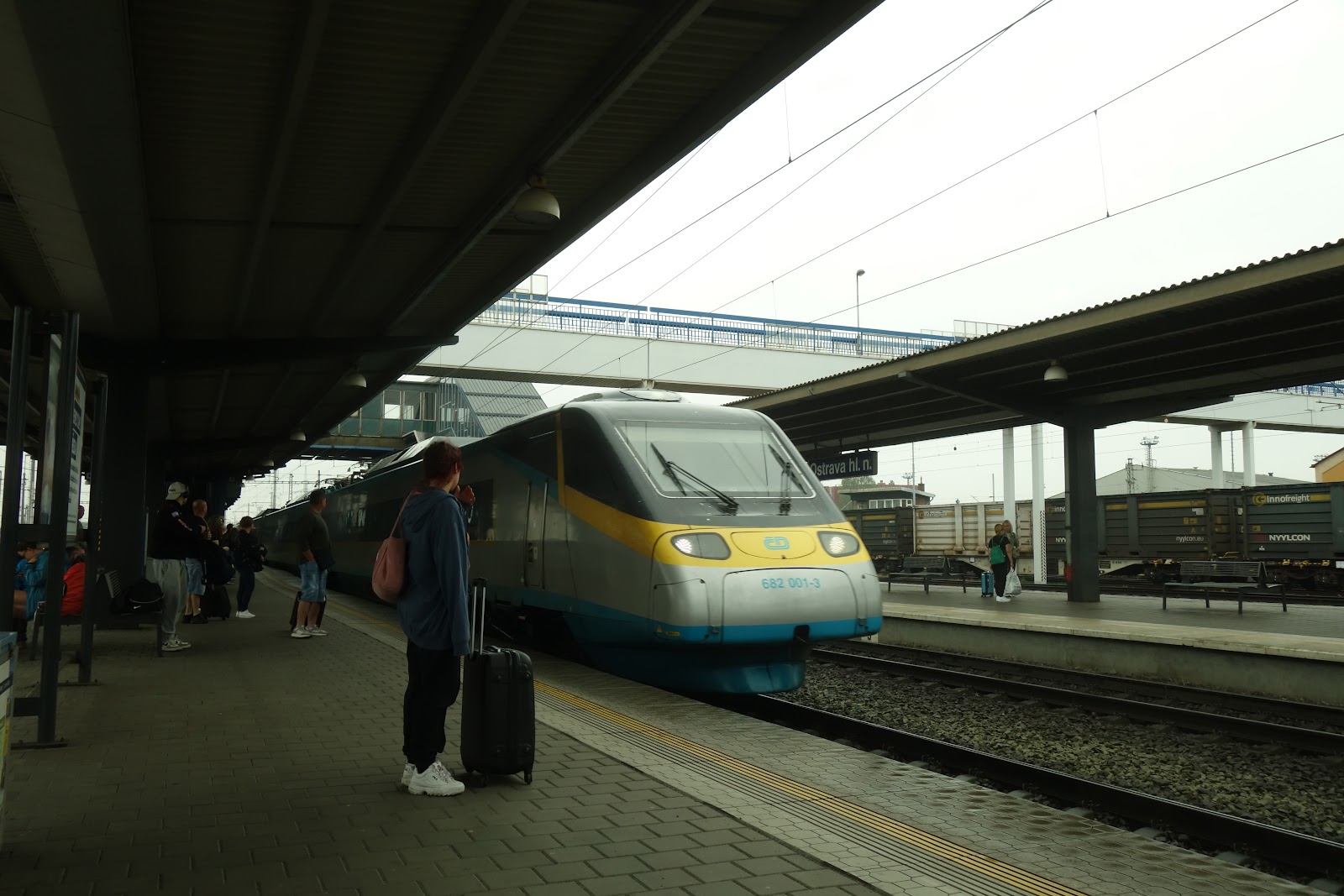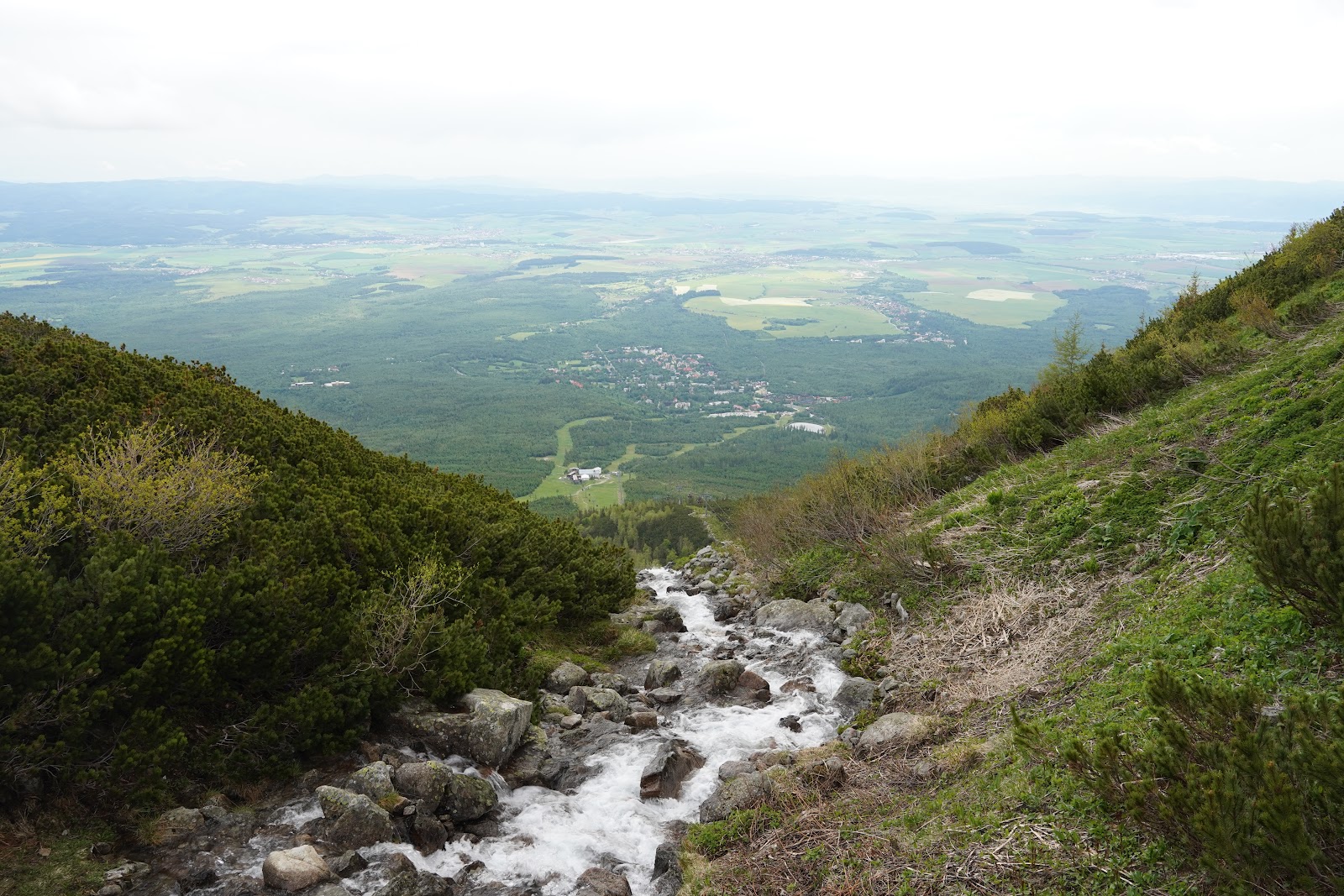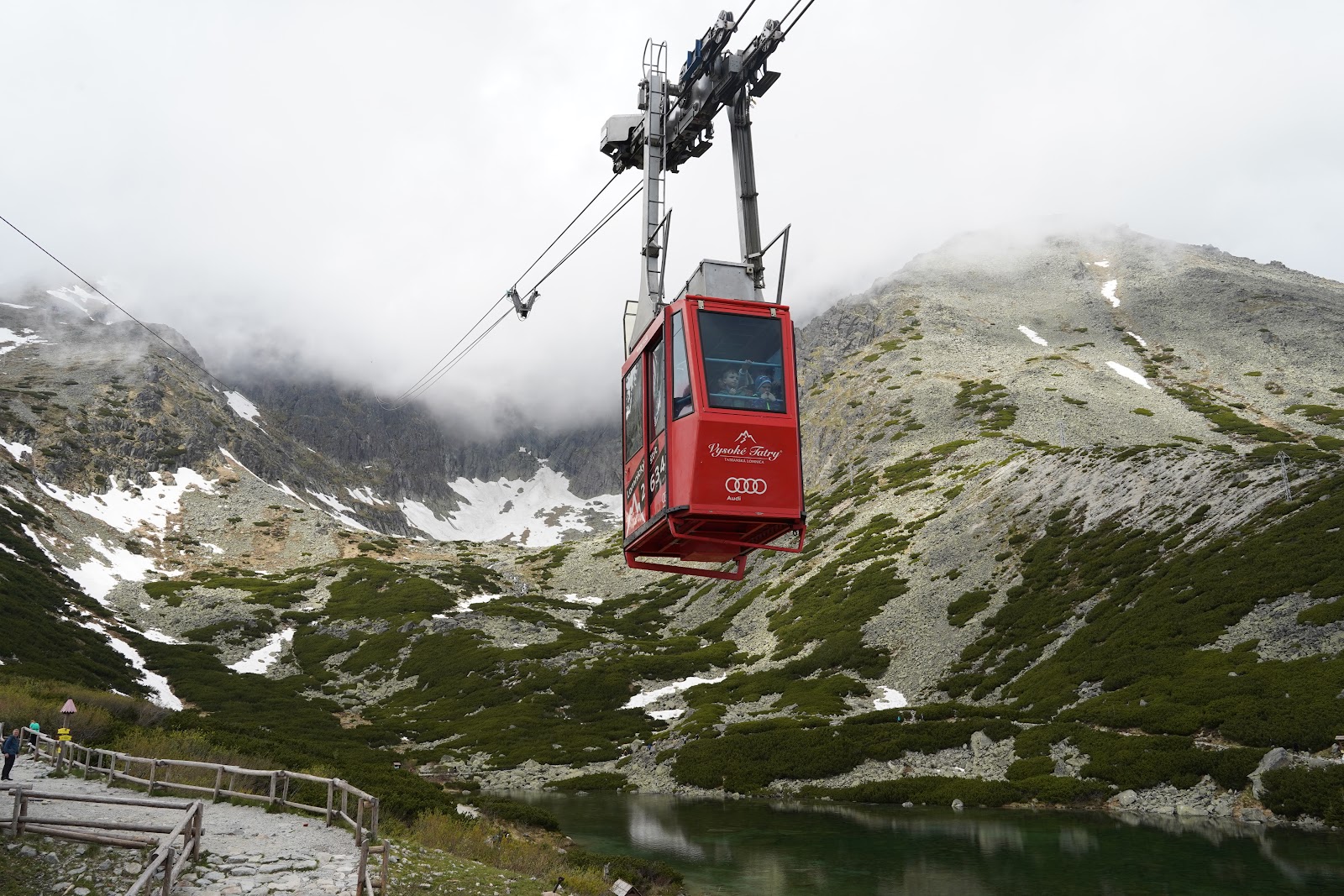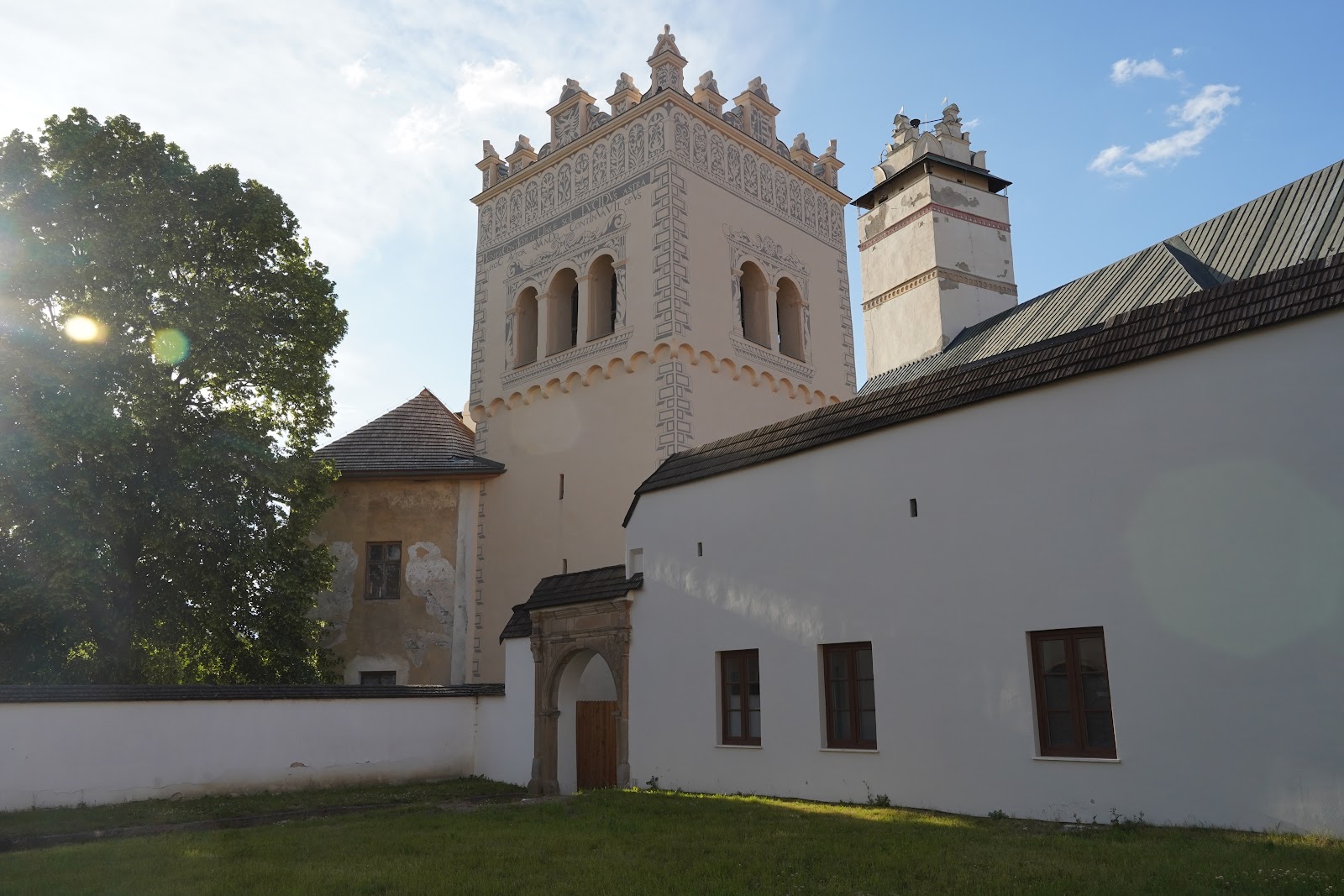In to the high Tatra
After I have packed my gear I leave the anonymous hotel in Ostrava where I have stayed for two nights and walk to Max, the place where I had breakfast yesterday. I am glad I did, because a table is set for me. But today I am not the only guest. There are a couple of what I take for local builders. For what I can see they are dressed in a kind of wrestling suit in blue and white, which leaves most of their massive upper body naked. When I get my cappuccino they order their second beer. Eventually they are joined by a young guy who is satisfied with orange juice.
Restaurant of Hotel Max
When they eventually get up I see that the whole suit, which starts at the upper leg, is tight fitting. Their huge bellies fill the elastic fabric like a blown up balloon. Below the belly, their testicles are nicely sculptured out. On their ass I see the word “Fin” in white capital letters. Their bellies thrust forward a finish flag. They are part of the Finnish national icehockey team. Yesterday they lost in the quarter final against Sweden.
Breakfast
I wanted to take reservation free trains from Ostrava to Poprad Tatry, my destination for the day. That would have taken 6.5 hours. When I arrive at the station at 9 am I notice that there is an express train leaving for Kosice at 9.15. It is also 10 minutes late. Nobody is waiting at the ticket counter and the lady is very quick to provide me with a window seat reservation. The direct train will bring me to Poprad in little more than 3 hours.
Ostrava station
It is a Pendolino like those originally used in Italy. It is late for technical reasons, and the delay will increase to half an hour until I arrive. Since I do not have to catch any connections and will be there so much earlier I do not care.
The Pendolino is arriving
For the reservation fee of less than 2 € (77 krc) I get free water, there is more space since there are only three seats in a row, there is working Wifi, and there is a restaurant car but you also can order at your seat via a QR code. The conductor both checks my interrail ticket and my reservation. Next to me a girl, blond, who stares listlessly at a movie while playing around with her phone. She does not notice that there is a movie going on outside.
Station on the route from Ostrava to Poprad
Not far after Ostrava I see two crashed Slovak red and white passenger carriages in the ditch next to the track. I look up recent train accidents in Czech Republic but cannot find any. The next sight is Trinec, a town which seems to mainly consist of a huge steel factory still in operation. Then the line runs through nice country side, after Vrutky you see the lower Tatra mountains at the horizon. There still is quite some snow on the northern slopes.
Like in Czech Republic they keep working on the line in Slovakia while the trains are running. During the work our train moves to the other track. As a warning the approaching train blows the whistle several times. Along the line they also have noise screens, but as a courtesy to the traveler they have glass at the height of the window of our train so that you can see what is behind. The noise screens are placed a bit at random: there are noise screens, but no settlement, and settlements, but no noise screens.
While on the train I have booked a room in Hotel Satel in Poprad. The hotel is a huge former communist time concrete block. My experience is that they usually come with spacious rooms and all amenities you need. You have to walk up a flight of stairs to get to the entrance to better appreciate the honor to be accepted here. But there is a lift and a balcony from where I can enjoy the view of the mountains. There is a similar building next door, former hotel Gerlach, which is closed and is slowly decaying.
Hotel Satel and ...
However, my room is not ready yet. I leave my luggage and walk back to the station. It looks like it is going to rain soon, so why not go on a little sightseeing trip by train? Above Poprad’s main station is the terminus of the Tatra Electric Railway (Tatranské Elektrické Železnice (TEŽ)). It is an electric narrow gauge railway built in 1908 which connects Poprad with the resorts at the base of the Tatra mountains. The trains leaving Poprad run to Štrbské Pleso via Starý Smokovec. There, there is a connection to Tatranská Lomnica. In Štrbské Pleso a cog railway runs down to Štrba. In Štrba and Tatranská Lomnica regular trains also run back to Poprad. So there is a chance to do two little loops by using these branch lines.
The station of Starý Smokovec in the rain
Starý Smokovec is the main Slovak resort town at the base of the Tatra mountains. It is not old. The oldest wooden house is villa Flora from 1839. There are some beautiful old Villas in the town, but the setting is somewhat spoiled by the construction of the well known modern hotel blocks built in the 1960’s and 1970’s. Like in neighboring Tatranská Lomnica the buildings are in a park like setting. While I walk around an enormous deer basically jumps into my lap. Some of the modern hotels are empty, or maybe only open for the winter season. Some are classics, even though they are modern, like the Moravia in Tatranská Lomnica. Both settlements have their huge grand hotel, and if you ever wanted to stay in one of these behemoths for a romantic weekend the Grand Hotel Praha in Tatranská Lomnica is probably one of the few affordable options.
The cafe in the Grand Hotel
It soon starts raining seriously and I retreat into one of the nice old wooden buildings into what is called “sherpa cafe”. The two friendly ladies working there have just finished their last cake. But I get a cappuccino with a smile. It turns out that the cafe is also a little museum honoring the local sherpas…. The mountain huts in the Tatra are still supplied by carriers. They are called Horsky nosip in Slovak. The sherpa cafe is owned by one of them. On a wooden frame they carry all the provisions, including beer kegs, up the trails to the huts. In fact I see one coming down with the empty frame the next day. They are paid by the load: 1 € per kg. They carry more than 70 kg in one go. It is not a way to get rich and it is definitely not good for your knees. But it is a way of life.
Judging from all the fine, brand new gear many Slovaks are serious hikers and mountaineers. Never have I seen so many kids enjoying to be carried around in backpacks. In contrast to the Austrian mountains a couple of days ago there are practically no foreigners, but mainly Slovak or Polish visitors. They all seem to meet in this one train I take to Štrbské Pleso and the connecting cog railway train down to Štrba.
The load of a sherpa and ...
The connections are very tight. There are 3 minutes to transfer from the between the narrow gauge trains and the main line train is already there when the cog train arrives in the station of Štrba. I was standing at the door and got it. It must have been waiting for the arrival of the cog train. Another example of the excellent service provided by the Czech and Slovak railways. And there will be more.
After I come back and have finally checked into my spacious room it is time for dinner. I had been on trains or walking all day and there was not even time for lunch. So I walk into the old center of Poprad to look for a place to eat. But I am welcomed with a blasting loudspeaker and the noise of cars. There is a kind of rallye going on. Mostly heavy men arrive in little cars covered with sponsoring advertisements. The back seat windows show their names. They make as much noise as possible to compensate for the size of the cars. Although it is still drizzling I make up my mind to walk for 2 km to Soboda, an old, historic town which now is a suburb of Poprad. I hope it is more quiet there.
The center of Sobota is not more than 2 streets
Indeed, the quiet cobbled street in Soboda are a pleasant difference to the noise in the center of Poprad. However, most of the restaurants are closed. The only one which is open has a kind of degustation, which is only for reserved guests. However, the sun comes out and sheds a beautiful light on the colorful old houses.
Since I don’t find an open restaurant I walk back and get lost in the huge yard of the Tatra waggon factory. It is the biggest local employer. Somehow I have walked past the entrance without noticing at a parking lot and nobody stopped me. But eventually I find back to Egidia square, the main square of Poprad, which is now completely filled with race cars and those men showing them off. I end up in Tatras, a restaurant specialized in dishes related to beer. A nightmare for the non-alcoholic. I have a beer soup as a starter, which is excellent, and local fish. A nice dinner and for once it has an advantage that the restaurant has no windows opening to the main square. So I miss the noise of the departing race cars and when I walk back to the hotel the square is empty. However, my room has a balcony and my evening is entertained with the roaring sound of those blasting wonna be racers doing their show on the roads around town. This will continue during my stay in Poprad. They are everywhere.
The TEZ station in Poprad with the high Tatra in the background
The next day starts with bright sunshine. I try hard to get an early start and take the narrow gauge train to Tatranská Lomnica. From there, a cable car goes up to Lomnický štít. With 2634 m this the second highest mountain in Slovakia.
This is part of a ski area. To go up to Lomnický štít you have to take three different cable cars. At the bottom departure station they sell tickets at a shop which is typical for those found in ski resorts around the world. For 65 € I get a ticket with a QR code to enter all three cable cars and a separate reservation ticket for the ride to the top of the mountain with cable car number 3 at 1 pm. I am a bit surprised because when I buy the ticket it is not yet 11.00 am. Clouds have started to move in and I am a bit afraid that the mountain will be covered in mist when I finally get to the top after 1 pm.
The lake at Skalnaté pleso
The lowest leg of the cable cars is a gondola lift which clearly has seen better times. There are few people and I get a gondola for myself. It is designed for 4 people with a capacity of 320 kg. Should be enough for me. The glass is scratched. When I move the gondola sways precariously. The gondolas in the second section are bigger and more modern.
When I arrive at the second stopover point, Skalnaté pleso, at around 11.15 am, the top of the mountains is covered in clouds. The station is overlooking a mountain lake. Most people seem to come here to walk the trail around the lake. Since the path is covered with big, uneven rocks it is not such a simple thing to do. A fox watches amused how we humans stumble across the rocks.
Then I see the cable car. It is one tiny little red gondola which climbs up the cable to slowly disappear in the mist. It covers the height difference from 1754 m to 2634 m without an intermediate pillar. The cables sag like a wet clothes line. The little gondola is packed like a can of sausages. I have ticket number 15 for the 1 pm run, and 15 seem to be a lot for such a little gondola. At that moment, for me this is the scariest cable car I have ever seen.
Inside the station there is a little timeline about the construction. The line was built in 1940, but in 1945 the lower station was destroyed in the Slovak uprising. In 1949 it operated again. In 1986 the only intermediate pillar was removed and the technical installation was renewed. In 1989 a cabin built by von Roll in Switzerland was introduced. The mentioning of a Swiss company is always reassuring. In addition I see that it had its last technical inspection 4 days ago. So at 1 pm I press myself into the cabin with 15 others (there is also an operator).
Almost magically the clouds disappear in the moment the cabin starts moving. We do not disappear in the mist, but we pass rocks on both sides at such a close distance that a bit of wind must smash the gondola against the rock face. The scariest moment is before it arrives at the top. It almost comes to a stop, and everybody suddenly is even stiller than before. On 3 sides, the rocks are very close. Then it slowly moves into the station. We get a number for the return trip down. 50 minutes after arrival the number will be called and then we have to leave again. In case of trouble there is a nice looking guest house in the summit station.
Most of the clouds have disappeared. It is sunny at the top. Around us rugged rock ridges which arise sharp from the plains below. The view reaches far into Slovakia to the South and Poland to the north. There is still some snow in the crevasses between the rocks but apparently it is less than usual for this time of the year.
For the entertainment and thrill of the visitors they have built a similar viewing finger hovering above the abyss like in the Dachstein at Hallstatt in Austria. One by one people take their selfies. Then some have a drink to waste away the 50 minutes waiting time to go down again.
I get into a conversation with a friendly Pole who lives in Eindhoven in the Netherlands. He is here with his mother. Tomorrow is mother’s day and he invited her for a little trip. When I tell him about my interrail trip it turns out that he has never heard of a thing like interrail. He is intrigued. He is fed up with cars breaking down on a vacation trip, parking fees or regulations to limit the use of cars in cities. He has worked as a truck driver for a while. For farewell he shakes my hand warmly.
After 50 minutes our time is up and I take all the three cable cars down back to the station. It was about time. Before we left a thunderstorm had moved in quickly. There was no view of the mountains any more and we left the top in a cloud of mist.
In the regular gauge part of the station of Tatranská Lomnica a little red and white railcar is waiting for the trip to Poprad Tatry. I will only take it to Studeny Potok. There there is a connecting train to Kežmarok. Connection is not the correct work. Both train trips take around 15 minutes but the waiting time between trains is more than an hour. There is nobody else getting off at Studeny Potok.
Studeny Potok has three platforms, one for the train to Tatranská Lomnica and two for trains in the direction of Stara Lubovna. Trains on both lines run 2 hourly. For these services the station employs two employees. A woman waves of the trains, a man walks to the switches and changes the direction by hand when a train to or from Tatranská Lomnica passes.
Unfortunately there is no bench at the station. I would have loved to use the hour to have a nap. So I sit down on the steps to doze away. But as soon as I sit people start to arrive. It is a strange crowd, obviously most don’t speak Slovak. Some carry big shopping bags from the supermarket along the main road that passes the station. Maybe there is a refugee camp somewhere in the area. The Ukrainian border is not so far away.
Eventually the railcar to Stara Lubovna arrives. It has to wait here for the one coming from Stara Lubovna to go to Poprad Tatry. It is full. Some people have to stand. For me, it is only a 15 min trip to Kežmarok, so it does not matter.
The conductrice walks through several times asking for tickets. She does not want to see mine. When we arrive in the beautiful, art-deco station of Kežmarok, people get up and stand in line at the door to get out. A loud, angry discussion starts in the middle of the train between the conductrice and a woman. A girl speaking english explains to me that there are people without a ticket. The conductrice does not unlock the doors until the police comes or these people have paid their fare. Eventually a young guy convinces her to let out those people by the back door who have got a ticket. When I get out the police has just arrived. It is the first time that it happens to me that a train conductor takes all his train passengers hostage because someone does not want to pay. When I start walking into town the train is already 20 min late and they are still discussing at the door.
The name of the town, Kežmarok, originates from the medieval right to have a cheese market, in German Käsemarkt. It is an area which was in the borderlands and a lot of people came through: the Saxons, Germans, Hungarian, Slovaks and the Hussites. For a long time it was the stronghold of the noble Hungarian Thököly family. Until the second world war the town had a strong Jewish minority and a German majority. The Jews were deported and murdered and the Germans were evacuated at the end of WWII. That does not take away that the waiter in the restaurant where I had dinner spoke excellent German. Most of the people in the streets I saw were old. When a couple of women whom I took for old locals started talking they did it in German with a strong Berlin accent. In 2001 more than 95% of the towns folk were Slovak, 0.43% German and no Hungarians left.
A similar development had happened in Poprad and Sobota. In 1910 the portion of Slovak, Hungarian and German inhabitants was about the same. Both Hungarians and Germans had to leave at the end of the war.
City center of Kežmarok
The town has a castle, a couple of nice churches and several beautiful Renaissance merchants houses along the tree-lined cobbled streets. But its main attraction is the Wooden articular church built in 1681. At the time the town was Hungarian and catholic, but the protestants were allowed to built a church. Since there was no money the church had to built from the cheapest material – wood. Even the nails are from wood. Together with similar towns it was considered a world heritage monument by UNESCO. And I missed it. I also missed the restored Jewish cemetery and Jánošík. The latter is a Russian tank decorating a war memorial.
Nevertheless the little detour to have a walk in Kežmarok was enjoyable and I had an excellent dinner with two bottles of this very pleasant black beer the Slovaks and Czecks are famous for. It was already getting dark when I took the 9 pm train back to Poprad.
When I arrived in the station in Poprad I noticed that the ticket counter was still open. The lady spoke excellent English and was able to provide me with the reservations for two ongoing trains for the next morning. The imbecile managers of the German or Dutch railways should come to Slovakia and ask them how to run a railway.
I am sure I want to have more time to explore this interesting area more thoroughly. And then I will also visit the wooden church in Kežmarok.
When I came back to my hotel I couldn’t avoid to have a look at myself in profile in the mirror. There was a certain similarity to some members of the Finnish national icehockey team. I only have to get one of those suits…. Or loose weight.
Kežmarok station
Another 3030 km to Kars.
Link to previous post:














































No comments:
Post a Comment